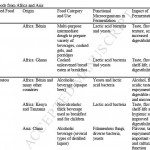Well I must say I never thought breadfruit would make it to Newsweek, but it has. Well done, Diane!
Counting calories conundrum
Regardless of how much raw energy is in the food, factors such as texture, cooking method and fibre content can all alter the number of calories your body is able to extract from it.
Reminding us that people eat meals, not ingredients. Via.
More organic meta-analysis
Never rains but it pours. Hardly had I finished writing about the dismantling of the “conservation agriculture” narrative, that news is out of a serious going over for (part of) the organic agriculture one as well.
An independent review commissioned by the Food Standards Agency (FSA) shows that there are no important differences in the nutrition content, or any additional health benefits, of organic food when compared with conventionally produced food. The focus of the review was the nutritional content of foodstuffs.
Only about a third of the 162 studies from the past 50 years considered in the meta-analysis saw “a small number of differences in nutrition between organic and conventionally produced food but not large enough to be of any public health relevance.” Studies such as this one, presumably.
This follows a meta-analysis by the American Council on Science and Health which came to a similarly skeptical conclusion. That report was criticized in some quarters. And apparently the Soil Association has expressed some reservations about this latest study and called for better research. We can all go along with that, I think..
LATER. Reaction to the report from Civil Eats, US Food Policy and The Organic Centre. Bottom line is perhaps put best by Parke Wilde:
It is wisest to make your decisions about organic and conventional food primarily based on your assessment of the environmental considerations. The nutrient differences are not as decisive.
Nibbles: Fisheries, Mangroves, European bison, Dormouse, Eating & drinking heirlooms, Apios, Kombucha, Organic and health
- Donwload a guide to sustainable sushi.
- It was World Mangrove Day last Sunday. Who knew.
- Poland/Belarus’s Bialowieza Primeval Forest and its bison threatened by climate change, politics.
- Endangered dormouse found crossing highway, but is it the edible sort beloved of the Romans?
- “Endangered heritage breeds have one saving grace: They’re generally tasty.” Even in cocktails.
- Radix gets to grips with Apios americana. Good luck!
- Did someone say fermentation?
- Did someone say single-issue bores?
Forays in fermentation
![]()
There’s a couple of interesting articles about cereal fermentation in the latest Food Microbiology. Both basically say that fermentation is a useful way of getting more nutrition out of your staples. Rob Nout ((Nout, M. (2009). Rich nutrition from the poorest – cereal fermentations in Africa and Asia Food Microbiology DOI: 10.1016/j.fm.2009.07.002)) describes how various traditional fermented dishes are made in Africa and Asia, ranging from kenkey in Ghana to idli in Sri Lanka. The former is made from maize, the latter from rice. Here’s the part of the paper’s Table 1 which lists fermented foods made from maize and sorghum (pearl millet, finger millet and rice are also considered):
It can get complicated. Here’s how they make jnard in India (I’ve removed the references to ease the flow), for example:
Jnard is an opaque beer made from finger millet (Eleusine coracana). Although – judging by its description – it would seem similar to Tchoukoutou, its mode of processing is fundamentally different. Whereas Tchoukoutou is brewed from sorghum malt, Jnard is saccharified by the action of an indigenous amylolytic starter (Murcha) on previously soaked and cooked fingermillet paste. Murcha is a rice-based dried tablet containing a mixed microflora of filamentous fungi, yeasts and lactic acid bacteria, and differs from koji which is a concentrate of fungal conidia of e.g. Aspergillus oryzae, used in the preparation of soya sauce and similar products. The process of preparing Jnard includes an overnight soak of finger millet seeds to soften them, grinding to obtain a crushed mass which is cooked and cooled to about 30ºC. Then, pulverized Murcha is sprinkled in the cooked mass and during a 1-3 day incubation, saccharification, lactic fermentation and alcoholic fermentation take place simultaneously. Functional microorganisms of Murcha and similar Asian amylolytic starters are filamentous fungi (Amylomyces rouxii, Rhizopus oryzae, etc.) which produce a range of enzymes including glucoamylase that degrades starch directly into glucose; yeasts (Endomycopsis fibuligera, Saccharomyces cerevisiae, etc.) which ferment part of the glucose produced; and lactic acid bacteria (Enterococcus faecalis, Pediococcus pentosaceus and others) growing together with the yeasts. LAB are able to co-exist with yeasts in a protocooperative manner.
